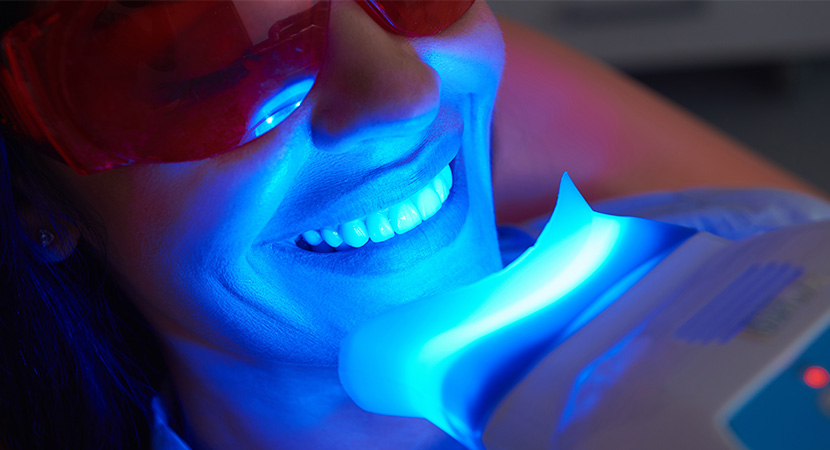
Teeth Whitening
When our teeth become discolored, especially when they darken, we invest a lot of time and money to improve their color.
Many people attach great importance to the appearance of their teeth. One-third of us believe that our smile is not white enough to be considered attractive. Although some may think that an attractive smile is insignificant, studies show that a whiter smile has a significant impact on perceived confidence and success.
Teeth whitening is a process of lightening your teeth to make them whiter, brightening the existing shade with various nuances.
Teeth whitening is a type of dental procedure that should only be performed under the prescription of a dentist or other licensed dental professional, such as a dental hygienist or dental therapist.
Since teeth whitening by a dentist or another dental professional is considered cosmetic therapy, it is usually performed privately. The cost of laser whitening varies but is more expensive than professional whitening.
Teeth whitening is not a long-term solution. It can last from a few months to three years, depending on the individual.
If you smoke or consume red wine, tea, or coffee, which can stain your teeth, the whitening effect will be short-lived.
Regardless of the treatment you choose, your gums may become sensitive to the chemicals used in teeth whitening, especially if you already have sensitive teeth. There is also a risk of gum burning, and some home whitening products can affect tooth enamel.
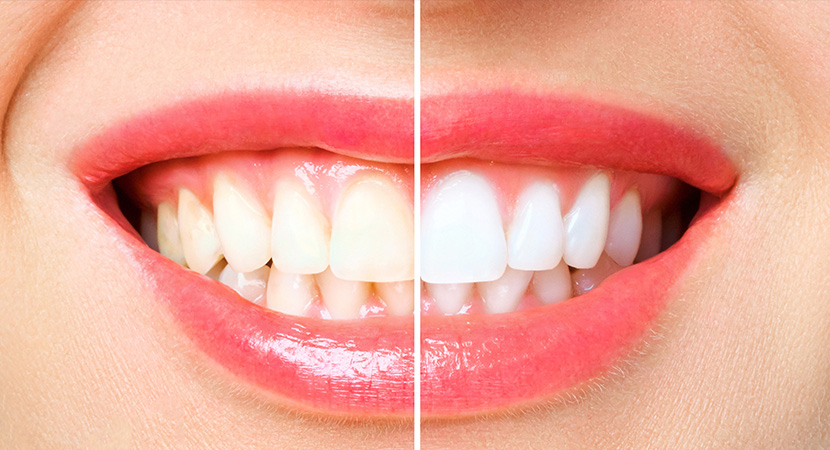
Why Do Teeth Discolor?
The dentist must identify the specific cause of staining or discoloration to apply the necessary therapy.
The color of the dentin, enamel, and any stains on the tooth determine its color. The overall color of the tooth is formed by a mixture of these colors.
Food and Beverages
Dark beverages are most likely the leading source of most tooth discoloration (at least after tobacco products). Whatever stains a white T-shirt can similarly stain your teeth. This includes liquids like red wine, coffee, tea, soda, sports drinks, etc. And if you're drinking one of these, chances are you're having it every day. Drinking coffee every morning for the rest of your life will undoubtedly change the overall color of your teeth. Darker foods like berries, tomato sauces, and curries can also be tough to grind down.
Genetics
Some of us naturally have darker teeth than others. The way our teeth form and the thickness of our enamel play an important role in this. Since the layer of dentin beneath your enamel, known as dentin, is naturally yellow, it's natural for it to be more visible in those with thinner enamel or larger overall teeth, such as canine teeth. Don't forget that the reason adult teeth appear yellower than baby teeth when they first come in is because they lack the same strong dentin underneath the outer enamel. The anatomical characteristics of teeth are absolutely something you can inherit from your parents, so if they have black teeth, there's a good chance you will too.
Aging
Whether we like it or not, our teeth naturally darken with age. All the dishes, drinks, and environment we've subjected them to can start to show. In combination with tooth wear, the combination of discoloration and enamel erosion can make us look older than we are. And if you've had previous dental work, such as fillings, you'll definitely see more discoloration around their edges when it's time to replace them.
Tobacco Use
Tobacco products can create some of the deepest and most clearly defined stains on teeth. Cleaning it can be quite difficult for your dental hygienist. Special equipment like an air polishing machine or electric scaler, however, can take a few minutes to remove the stain from the top layers of your enamel.
Cigarette stains, however, can penetrate through your teeth and may require whitening procedures to remove them. No matter what type of tobacco product you use, they can all leave stains. One isn't "better" or "worse" than the other.
Pregnancy
During pregnancy, many women have strange cravings and aversions to their diet. When your diet is rejected or you eat differently, you may notice some strange spots on your teeth that you're not used to. Additionally, you may have a sensitive gag reflex that prevents you from brushing your teeth as thoroughly as usual. Visible spots and tartar can start to form in just a few weeks, so you may notice symptoms as early as your first trimester due to morning sickness or exhaustion.
Medications, Vitamins, and Supplements
Some prescription medications, over-the-counter pharmaceuticals, and holistic supplements can discolor your teeth. One example is tetracycline, an antibiotic that used to be commonly used but was discontinued after it was discovered to cause permanent tooth discoloration. Not that the medication stains already erupted teeth; it affects the growth of teeth in children and even infants when given to a pregnant mother. Even now, some medications, like chlorhexidine, which ironically we use in the dental office, can cause temporary discoloration of teeth. If your dentist or oral surgeon prescribes it, use it only as directed.
Fluoride
There's such a thing as having too much of a good thing. Fluoride is the culprit in this case. While fluoride, like any other mineral, can be found in food, too much of it can be harmful to our teeth and bones. Especially if you ingest it. Maybe you drink well water and the levels of fluoride in the soil are extremely high or you swallow a fluoride mouth rinse every month. In both cases, it can lead to anatomical anomalies in your teeth and bones. Hyperfluorosis occurs when there is an excess of fluoride in the body. This causes your enamel to be sliced, deformed, or have brown spots on it.
Trauma and Nerve Death
When you get hit in the mouth, you're putting your teeth in danger. Traumatic injuries, like those sustained during sports activities, falling in the bathroom, a car accident, or even a child bumping their head into your mouth, can be excruciatingly painful. The long-term effects, however, may not be apparent for years, if not decades. If your tooth suddenly becomes darker than its neighbors, it's likely suffering from nerve death. The enamel is often darker, browner, or bluer than it should be.
Indications
Most people can have white teeth, but not every case is guaranteed to be effective or sufficient to make that person happy. Your dentist will advise you on the best type of whitening for you.
If you have any of the following conditions, teeth whitening may be suitable for you:
• Stains on the teeth that are widespread.
• Tooth discoloration.
• Tobacco and dietary stains, such as tea and coffee.
• Fluorosis of the teeth - Fluorosis with multiple zones on the teeth may benefit from whitening.
• Tetracycline staining - Not all cases of tetracycline staining will be completely removed, but many will improve quickly and may involve changes in your tooth, such as nerve death or root canal therapy.
Contraindications
Teeth whitening is not suitable for you if:
• You expect a miracle.
• Your dentist informs you that you have cavities, gum disease, or infections behind the teeth.
• You are expecting a child.
• You have tooth sensitivity, fissures, and exposed dentin; once resolved, these teeth may be subject to whitening.
• You have existing crowns or large fillings in the smile zone - existing crowns or fillings that need to be replaced after whitening may indicate that whitening is not ideal for you due to cost-effectiveness.
• You are fifty years old and have receding gums and noticeable yellow roots.
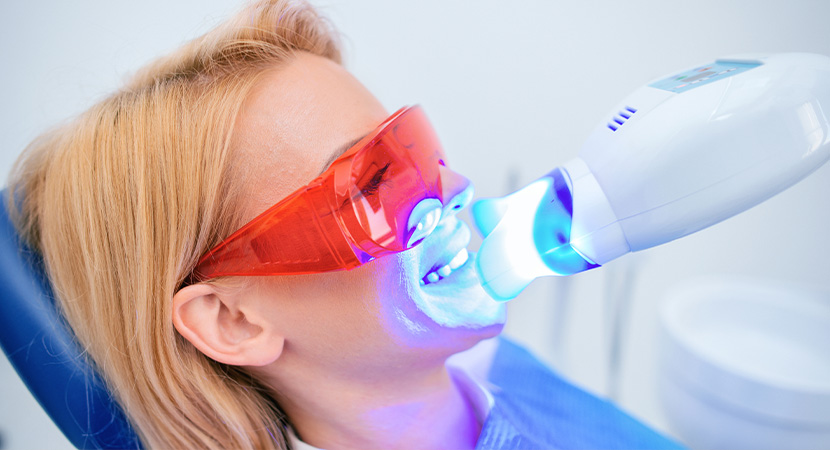
How successful is Teeth Whitening?
Studies show that teeth whitening is effective, and it's also cheaper and takes much less time compared to other techniques for making your teeth look whiter. It is claimed that 90% of people are successful with the whitening process.
The following factors affect the success of Teeth Whitening:
• Age - younger individuals see a quicker reduction in yellowness.
• The whitening method used – products based on carbamide peroxide last much longer than those based on hydrogen peroxide solutions.
• Concentration of the whitening agent - the higher the concentration of the agent, the more likely there will be negative effects. However, you will notice faster results.
• The degree of discoloration and the source of discoloration.
• How often you choose to whiten your teeth at home; if you simply whiten your teeth once or twice a month, you won't see a big difference.
• The custom-made tray for you and the number of whitening procedures performed, and the time spent whitening.
Possible side effects of Teeth Whitening:
• The most commonly reported adverse effects of whitening are tooth sensitivity and gum discomfort. Gum discomfort is usually caused by improperly placed whitening strips, using powerful gels for too long, and not removing excess gel. Other reported adverse effects include throat soreness, jaw pain from prolonged use of a tray, and slight tooth movement.
• Tooth sensitivity is the most commonly reported unwanted effect, experienced by more than half of those undergoing whitening procedures. Sensitivity is mainly due to the ability of whitening chemicals to penetrate through the tooth structure and enter the tooth (pulp), causing inflammation and discomfort at that location.
• Many whitening procedures can improve dry mouth, making teeth appear whiter. Dehydration can also cause tooth sensitivity. Sensitivity associated with teeth whitening is usually moderate, starts early when the whitening agent is applied to the tooth, and typically decreases as treatment progresses, with sensitivity disappearing when the whitening agent is removed.
• The easiest technique to avoid sensitivity is to use a fluoride gel or sensitive toothpaste before applying the whitening chemical. Using sensitive toothpaste after treatment will also help reduce sensitivity. You should also try to use the whitening tray every two days, not every day.
• To reduce sensitivity, use potassium nitrate with fluoride toothpaste two weeks before and during the whitening procedure.
• It is also reported that whitening chemicals have a harmful effect on the appearance of existing fillings in the mouth. Overall, dental fillings do not seem to change their color as much as surrounding teeth during the whitening process.

How is Teeth Whitening performed?
At Home Teeth Whitening
Whitening toothpaste:
Since they contain mild abrasives, all toothpaste removes surface stains. Some whitening toothpaste contains gentle polishing or chemical agents to help remove stains more effectively. Costs may vary. Whitening toothpaste only removes surface stains and does not contain bleach; over-the-counter and professional whitening products include carbamide peroxide or hydrogen peroxide, which bleach the color deep within the tooth. Whitening toothpaste can lighten the color of your teeth by about one shade. In comparison, prescribed in-office whitening by your dentist can lighten your teeth by three to eight shades.
Strips and teeth whitening gels:
Plastic whitening strips are shaped to fit the buccal/labial surfaces of the teeth and contain a thin layer of peroxide gel. Since their development in the late 1980s, several different types of whitening strips are now available on the market. The instructions for each whitening strip product vary, but the strips are usually used twice daily for 30 minutes for 14 days. The color of the teeth may lighten by one or two shades over several days. The endpoint of teeth whitening is influenced by the frequency of application as well as the composition of the product. Whitening gels are applied with a small brush on the tooth surface. The gels contain peroxide and should be applied twice daily for 14 days.
Whitening mouthwashes:
Whitening mouthwashes are among the newest whitening solutions on the market. Like other mouthwashes, they freshen breath while simultaneously reducing plaque on teeth and gum diseases. However, some of these products contain chemicals that whiten teeth, such as hydrogen peroxide. According to manufacturers, results may take up to 12 weeks. Shake them in your mouth for 60 seconds before brushing your teeth twice a day. However, some experts believe that mouthwashes are not as successful as other over-the-counter whitening solutions. Since whitening mouthwashes are in contact with the teeth for only a short period – about 2 minutes each day versus 30 minutes for many strips – they may have less impact.
Tray-based teeth whitening:
Wearing a custom-fitted tray containing whitening gel with carbamide peroxide overnight or for two to four hours each day leads to tray-based teeth whitening. If the manufacturer's instructions are followed, teeth can be whitened in three days and reduced by one or two shades. This type of teeth whitening is available both over-the-counter and through an oral health professional.
Baking soda teeth whitening:
Baking soda toothpaste is a safe, low-abrasive, and effective stain removal and teeth whitening agent. High-abrasion whitening toothpaste is harmful to dental tissue, so baking soda is a good substitute. No harmful effects have been observed in clinical studies of baking soda so far. It also includes acid-buffering components, making baking soda physiologically antibacterial at high concentrations and capable of suppressing the development of Streptococcus mutans. Baking soda may be beneficial for those prone to cavities as well as those desiring whiter teeth.
Charcoal teeth whitening:
Activated charcoal is a fine black powder derived from natural ingredients such as coconut shells, olive pits, lightly burned wood, and peat. When the powder is oxidized at high temperatures, it becomes activated. Activated charcoal is extremely porous and adsorbent. Additionally, it has a large surface area. Unlike absorbent substances, the adsorptive property of activated charcoal allows it to bind to toxins and odors rather than soak them up (absorb). According to the American Dental Association, the abrasive texture of activated charcoal may actually harm rather than whiten teeth by wearing them down. Despite the lack of scientific evidence, some people swear by the ability of activated charcoal to remove tooth stains and whiten teeth.
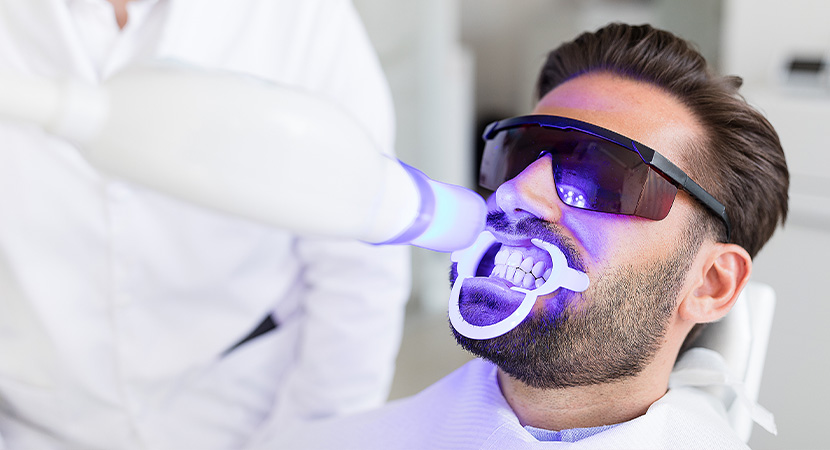
Teeth Whitening at the dentist
Laser teeth whitening:
Laser teeth whitening does not use lasers in the traditional sense. Lasers require specialized training and are used to treat problems such as drill-free fillings and gum diseases. However, "laser teeth whitening" is a teeth whitening procedure activated by light, combining UV radiation with stain-oxidizing solutions to accelerate stain removal. When the light is activated, the gel acts faster, so the treatment requires only one session. The peroxide in the teeth whitening gel, combined with appropriate lighting, effectively breaks down the discolored particles in the pores of your teeth. The gel would function more slowly without the lights. If you remember the process of the catalyst from high school science, the light acts as a catalyst.
Advantages:
• Completed in just 1-1.5 hours.
• Results up to 7-8+ shades whiter.
• Compliment for healthy teeth.
• Can be used as a standalone cosmetic treatment.
• Teeth whitening at the dentist is superior to other aesthetic services.
• Regular touch-ups maintain white teeth.
• At a lower cost than dental veneers or crowns.
Disadvantages:
• May cause sensitivity.
• Often requires a home maintenance kit to sustain results.
• May require at-home whitening to make teeth slightly brighter.
• Costs more than at-home whitening systems.
• Costs 2-3 times more than whitening strips.
• Cannot be aesthetically compared to dental veneers and crowns.
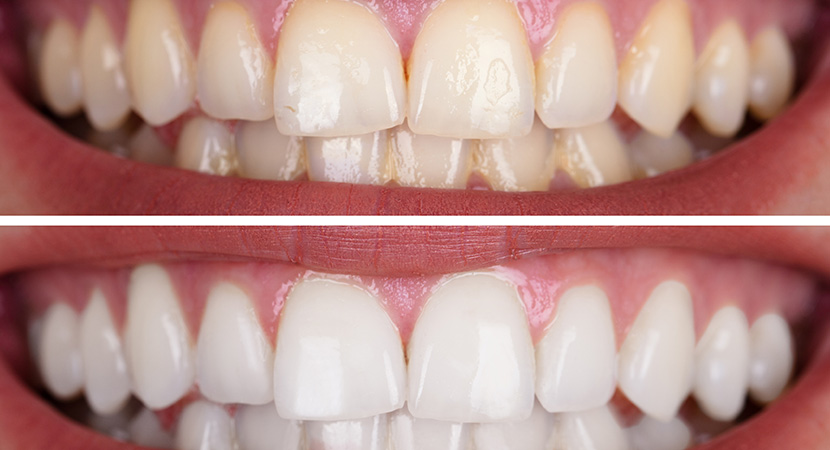
How long does teeth whitening last?
Teeth whitening services provided by dentists surpass any product available for purchase online or in stores. Most people will notice improvements for at least a year (even several years). However, if you consume a lot of coffee or tea, you may only be able to keep your teeth white for a few months without outside help. To continue your treatment and keep your teeth whiter for longer, you will need to change some behaviors and keep a touch-up kit at home.
If you have teeth whitening done on the same day at the dentist's office, they will usually provide you with an optional at-home kit, which includes a pair of trays and whitening gel. Whitening every 3-6 months (depending on your teeth) resets your level of whiteness. You should expect to be able to keep your teeth white for years if you continue to use your at-home kit, especially if you whiten your teeth after every six-month cleaning.
Conclusion
Teeth whitening is a process of lightening your teeth to make them whiter. It will not make your teeth brighter, but it will lighten the current shade by several shades.
Teeth whitening is a type of dental treatment that should only be performed by prescription from a dentist or other licensed dental professional, such as a dental hygienist or dental therapist.
Some cosmetic stores offer teeth whitening, but this is illegal if a dentist is not present and may endanger your oral health.
You can also purchase DIY teeth whitening products, but they come with their own set of risks.
Since teeth whitening from a dentist or other dental professional is considered a cosmetic therapy, it is usually performed privately. The cost of laser whitening varies but is more expensive than other whitening methods.


